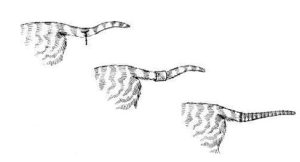EXTERNAL BLEEDING AND HOW TO STOP IT (HEMOSTASIS)
Most cuts through the skin will stop bleeding within five or six minutes of their occurrence. Those that do not or that are bleeding profusely need some kind of immediate care, especially if it’s going to be a while before you can enlist professional veterinary aid.
HOW TO USE A PRESSURE BANDAGE
A pressure bandage is the best method of hemostasis or stopping bleeding. If a gauze pad is available, place this directly over the wound, then apply the bandage over it. Any clean strip of material can be used for a bandage. Gauze roller bandage, a strip of clean sheet, or an elastic bandage are best since persistent bleeding causes seepage that you can see through such bandages. If the wound is on the trunk or you plan to bandage a limb only temporarily, apply several wraps of bandage firmly (not tightly) and directly over the wound. If the bandage is to be left on a limb for several hours or more, it should be applied over the wound and down the leg to cover the foot as well. This will prevent swelling and ischemia (lack of blood and oxygen) of the part of the limb below the bandage. This rule applies to bandaging the tail as well. If you cannot apply a pressure bandage, firm, direct pressure (with your bare hand, if necessary) over the wound for several minutes will often stop bleeding.
APPLYING A PRESSURE BANDAGE TO THE TAIL
If a pressure bandage successfully stops the bleeding and no other problems are apparent, you can usually wait several hours or overnight, if necessary, to have the wound examined and treated. An exception is a chest wound in which there are air bubbles in the blood or that is accompanied by the sound of air moving in and out of it. Wounds like this may be associated with air leakage into the chest cavity from outside, which can cause difficulty breathing and fatal lung compression. Once covered, such wounds should remain so, and immediate veterinary aid should be sought. Do not disturb any foreign body protruding from such a wound before seeking a veterinarian’s advice.
Most wounds severe enough to require a pressure bandage will need suturing (sewing closed) for proper and most rapid healing. (Any wound that gapes open is likely to benefit from suturing.)
TOURNIQUET
HOW TO APPLY A TOURNIQUET
A tourniquet is a second and much less desirable method of achieving hemostasis. Tourniquets are useful only for bleeding involving a limb or the tail. They should be loosened at least every fifteen minutes to allow reoxygenation of tissues. Use any strong cord, rope, bandage strip, or even a piece of panty hose to make a tourniquet.
Form a loop and apply it to the extremity between the body and the wound. (It is easiest to apply it at a joint to prevent slippage.) Watch the change in blood flow to determine how tightly to tie the tourniquet. Proper application will usually cause an immediate and definite slowing of blood seepage. When you achieve sufficient slowing, stop tightening the tourniquet. (Don’t expect a completely blood-free area.) Then consider replacing the tourniquet with a pressure bandage if at all possible.
Also ask:
What are the 3 ways that you can control external bleeding?
What is the main method to stop any external bleeding?
What are the 4 steps to controlling external bleeding?
What is the fastest and most effective way to stop external bleeding?

